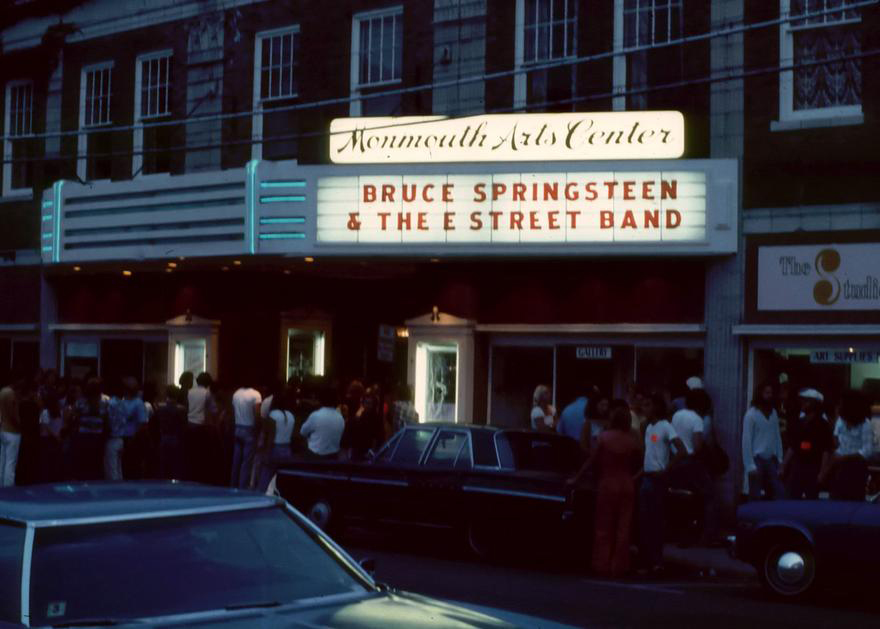Count Basie Center History

Originally opened in 1926 as Reade’s Carlton Theater, the Count Basie Center for the Arts in Red Bank has grown to become of the nation’s most celebrated performing arts centers. The Basie Center’s 1,568-seat historic theater is listed on the National Register of Historic Places in America, consistently recognized by Pollstar magazine as one of the nation’s top-performing live event venues, and everyone from Tony Bennett and Bruce Springsteen, to Ringo Starr and William J. “Count” Basie himself have performed on its historic stage.
In fact, Bennett has called the Basie “my favorite place.” Art Garfunkel once remarked, “This hall is to a singer what Steinway is to a pianist.” And Lyle Lovett, a frequent Basie Center performer, has long praised the theater, making a point to tell his audiences “this is one of the nicest sounding rooms in the whole United States of America.”
For 40+ years, Reade’s Carlton Theater hosted everything from vaudeville to films, local theater and touring productions, concerts and more. By the mid-1960s, like so much treasured, architectural wonders of the gilded age, the Carlton fell into disrepair, forgotten against the rise of shopping malls, home television and multi-theater cineplexes.

In 1971, funding from the Junior League of Monmouth County and New Jersey State Council on the Arts helped create the Monmouth County Arts Council (MCAC). With an eye on preserving the past, the MCAC almost immediately focused on preserving the Carlton.
The effort proved harder than planned. However, in 1973, an anonymous donation allowed the MCAC to purchase the Carlton for just $96,665 — several hundred thousand dollars less than it cost to construct 47 years earlier. A press release heralded, “The Monmouth County Arts Council has received an anonymous gift from a foundation enabling it to purchase the Carlton Theatre in Red Bank, with the stipulation that the theatre be renovated into an attractive and functional arts center for the entire county.” Along with the donation came a new name: the Monmouth Arts Center.
Thanks to the MCAC and an ever-growing area music scene, the Monmouth Arts Center became viable. In August 1974, just months after then-Rolling Stone journalist Jon Landau proclaimed him the future of rock and roll, local musician Bruce Springsteen and his E Street Band took the historic stage. A year later, just weeks after Springsteen appeared on the covers of both Time and Newsweek magazines, the band returned for a performance dubbed “The Homecoming.”
Decades before Bruce Springsteen, however, another area musician – jazz great William J. “Count” Basie – established himself as one of music’s all-time greats. In 1961, just weeks after performing for President John F. Kennedy’s inauguration, Basie made a homecoming performance at the Carlton, drawing more than 1700 fans in the theater’s seats and glass-lined lobby. Basie made several returns in the years to follow: in 1974 for a concert held in honor of his 70th birthday, and for a 1979 performance to benefit Shrewsbury’s A.M.E. Zion Church.
Just weeks after  the death of his wife Catherine in 1983, Basie made his final appearance at the theater. Less than a year later, the jazz legend succumbed to cancer.
the death of his wife Catherine in 1983, Basie made his final appearance at the theater. Less than a year later, the jazz legend succumbed to cancer.
In November 1984, just six months removed from his death, the Monmouth Arts Center was renamed to honor Basie, then wholly recognized as Red Bank’s most famous son.
In years to come, the Basie would establish itself as a nonprofit organization, with a mission to serve the people of the State of New Jersey by providing a broad spectrum of quality entertainment and education programs that reflect and celebrate the diversity of the region.
The Basie Center’s Academy of the Arts has yielded stars in music and Broadway, and its work in area schools to promote the arts in education has been recognized throughout the state of New Jersey.
A monumental interior restoration was completed in 2008, funded in part by a performance by Springsteen and the E-Street Band. The project restored the theater to its original, Spanish-influenced 1926 luster. Two years later, the building’s iconic façade was restored.
And today, the Count Basie Theatre has become the Count Basie Center for the Arts, reflecting its celebrated $26 million capital campaign and the goal of expanding the facility into a true, regional center for the performing arts. Construction is underway on the west side of the facility, with the Jay And Linda Grunin Arts and Education Building set to house rehearsal spaces, additional classrooms and the Basie Center’s as-yet-unnamed second performance space. On the facility’s east side, plans are in place to create a spacious, glass-lined lobby, barrier-free amenities and upgrades, and the Stillwell-Larkin Pavilion, which will serve as the entrance to a new outdoor public arts plaza.
At 90 years old and growing stronger, the Count Basie Center for the Arts aims to be the premier center for the performing and visual arts, inspiring, educating and entertaining through its diverse and engaging offerings and reflecting the diversity of the region. As a nonprofit organization, the Basie is committed to creating opportunities for participation and understanding the arts by collaborating with creators, organizations, and schools, and as a catalyst to harnessing the economic vitality of the arts and enriching our region’s quality of life.






